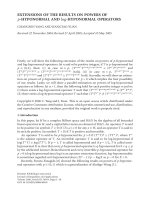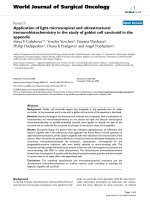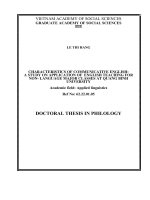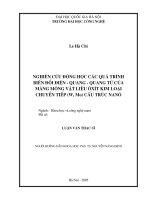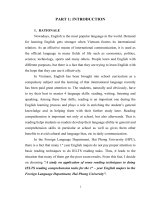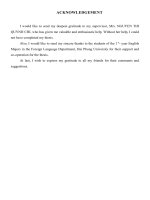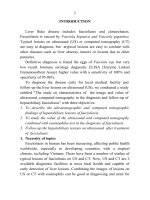the study on application of literal translation and free translation in translating english – vietnamese documents at international at vtcnews
Bạn đang xem bản rút gọn của tài liệu. Xem và tải ngay bản đầy đủ của tài liệu tại đây (398.65 KB, 71 trang )
Graduation Thesis
Academy of Finance
ACKNOWLEDGEMENT
During my research period, I have received great help and support from
many people to implement my research, broaden the ideas and finishthe final
report.
First of all, I would like to express my deep gratitude to my supervisor,
Mrs. Ngo Thi Viet Anh, Lecturer of Foreign Language Faculty, Academy of
Finance for her precious advice and close instructions that guide me through
this study.
Secondly, I myself would like to thank the teachers and supervisors of
the Faculty of
Foreign Languages, Academy of Finance. Thanks to the
related subjects such as Translation theory, Semmatic, Grammar, taught by
the lecturers of the faculty, we have been equipped useful knowledge to
conduct my study.
I also want to send my thanks to Mr. Vo Van Viet, Mr Dinh Duc Tung
and Ms. Do Huong, Journalistic translators of international department for
their support during my internship. Thanks to them, I had chance to practise
translation jobs and
access all necessary documents and articles and
opportunity to work with best journalist, editor and translator of VTCNEWS.
Ultimately, I owe my sincere thanks to my family and friends. Their
continuous assistance and encouragement helped me a lot during time of
internship and attempt to finish this study.
Graduation Thesis
Academy of Finance
ABSTRACT
.
This study is aimed at analyzing the application of free translation and
literal translation methods in tranlating English - Vietnamese documents at
international at VTCNEWS from 2011-2013 an then assessing effectiveness,
finding out some solutions to its shortcomings and giving some
recommendations to improve quality of translation. Data were collected from
5 articles which is published at internationl department so as to analyze
advantages and disadvantages as well as frequency and area of application of
two methods. Basing on above analysis, I have found that international
department has gained many achievements such as accuracy, faithfulness,
literalness in translated text. However, there still exists some problems such as
cultural inequivalence, unclearance in the TL. In the end of study are some
solutions that might be applied to solve the problems: Overcoming cultural
problems by using cultural substitution, dealing with cultural untranslatability.
Graduation Thesis
Academy of Finance
ABBREVIATION
SL
Source language
TL
Target Language
SV
Subject + Verb
SVO
Subject+ Verb + Object
SVA
Subject+ Verb+ Adverb
SVOO
Subject+ Verb+ Direct object+ Indirect Object
Graduation Thesis
Academy of Finance
TABLE OF CONTENT
DECLARATION....................................................................................................................I
ACKNOWLEDGEMENT....................................................................................................II
ABSTRACT.........................................................................................................................III
ABBREVIATION...............................................................................................................IV
TABLE OF CONTENT........................................................................................................V
INTRODUCTION.....................................................................................................1
1. Rationale.................................................................................................................1
2. Aims of study..........................................................................................................2
3. Scope of study.........................................................................................................3
4. Methods of study.....................................................................................................3
5. Organization of study..............................................................................................4
CHAPTER 1: THEORETICAL BACKGROUND...........................................................4
1.1 Translation theory.............................................................................................4
1.1.1Definition of translation...............................................................................4
1.1.2 Translation equivalence..............................................................................5
1.1.2.1 Form-based equivalence.........................................................................6
1.1.2.2 Meaning-based equivalence....................................................................6
1.1.2.3 Function-based equivalence....................................................................9
1.1.2.3. Quantitative equivalence......................................................................10
1.1.3. Translation procedure..............................................................................12
1.1.3.1. Transference.........................................................................................12
1.1.3.2. Naturalization.......................................................................................13
1.1.3.3 through translation................................................................................13
1.1.3.4 Shift or Transposition............................................................................13
1.1.3.5 Modulation............................................................................................14
Graduation Thesis
Academy of Finance
1.1.3.6 Cultural Equivalent...............................................................................15
1.1.3.7 Functional Equivalent...........................................................................15
1.1.3.8 Descriptive Equivalent..........................................................................16
1.1.4 Technical translation................................................................................17
1.1.5. Translation methods.................................................................................18
1.1.5.1 Literal translation method.....................................................................18
1.1.5.1.1 Definition...........................................................................................18
1.1.5.1.2 Characteristics....................................................................................19
1.1.6.2 Free translation method.........................................................................20
1.1.6.2.1 Definition...........................................................................................20
1.1.6.2.2 Characteristics....................................................................................21
1.1.7 Some factors making application of translation theory improve...........22
1.1.7.1 Extensive knowledge............................................................................22
1.1.7.2 Deeply understanding of background knowledge.................................24
CHAPTER II: THE APPLICATION OF LITERAL TRANSLATION AND FREE
TRANSLATION IN TRANSLATING ENGLISH-VIETNAMESE DOCUMENTS AT
INTERNATIONAL DEPARTMENT AT VTCNEWS....................................................25
2.1 Introduction of VTCNEWS............................................................................25
2.1.1. History of development............................................................................25
2.1.2 Overview of international department at VTCNEWS...........................26
2.2 The application of literal translation and free translation in translating
English – Vietnamese documents at international department at VTCNEWS.27
2.2.2 Literal translation method........................................................................27
2.2.2.1 Advantage of application of Literal translation method........................31
2.2.2.2 Disadvantage of application of Literal translation.................................32
2.2.3 Free translation method............................................................................33
2.2.3.1 Advantage of application of free translation method.............................38
2.2.3.2 Disadvantage of application of free translation.....................................39
2.3 Assessment of the application of two translation methods...........................40
Graduation Thesis
Academy of Finance
2.3.1 Frequency and area of application of two methods................................40
2.3.2 Assessment of effectiveness in applying two translation methods.........42
2.3.3 Problems and causes in applying two translation methods....................42
CHAPTER III: SOME SOLUTIONS AND RECOMMENDATIONS TO IMPROVE
THE APPLICATION OF LITERAL TRANSLATION AND FREE TRANSLATION
IN
TRANSLATING
ENGLISH
-
VIETNAMESE
DOCUMENTS
AT
INTERNATIONAL DEPARTMENT AT VTCNEWS...............................................44
3.1 Some solutions to cope with the problems in translation at international
department at VTCNEWS....................................................................................44
3.1.1 Overcoming cultural problems by using cultural substitutions.............44
3.1.2 Dealing with cultural untranslatability...................................................45
3.1.3 Deeply understanding the of background knowledge.............................47
3.2 Some recommendations and suggestions to improve quality of translation
in translating English - Vietnamese documents at international department at
VTCNEWS............................................................................................................. 48
3.2.1 VTCNEWS and international department..............................................48
3.2.1.1 Organizing monthly meetings for staff..................................................48
3.2.1.2 Holding parties and tours on holidays for staff.....................................49
3.2.1.3 Sending staff to professional training courses.......................................50
3.2.1.4 Setting up a public forum......................................................................50
3.2.2 Journalistic translators or Journalists.....................................................51
3.2.2.1 Double checking the translated text......................................................51
3.2.2.2 Creating a translation glossary..............................................................51
3.2.2.3 Using reliable supporting translation software......................................52
3.2.3 Future journalistic translators.................................................................52
3.2.3.1 Listening to the radio and watching TV everyday.................................52
3.2.3.2 Reading newspaper, reading books in many fields................................53
3.2.3.3 Practising translation.............................................................................53
3.2.3.4 Doing translation as an extra job...........................................................54
Graduation Thesis
Academy of Finance
3.2.3.5 Participating seminars related to Journalistic translation......................54
3.2.3.6 Travelling if possible.............................................................................55
REFERENCE.......................................................................................................................56
Graduation Thesis
Academy of Finance
INTRODUCTION
1. Rationale
In the trend of globalization and dramatic development of science and
technology, translation in general and application of translation theory in
particular have become extremely necessary and attracted very much attention
from translation theorists and researchers.
Like many developing countries in the world, in national
industrialization and modernization, Vietnam needs continuously develop its
Journalism, one of the most important fields of the Media. When the living
condition is improved increasingly, the need of updating national news as well
as international news becomes an indispensable habit of everybody.
Therefore, how can we update international news in Vietnamese while not
much of us know English well? How can we open vision without updating
news that daily happening over the world? Then, Journalistic translation
becomes more important than ever. The English-Vietnamese translation plays
a very important role in the development of Media in general and Journalism
in particular. The application of translation theory, more specific are literal
translation and free translation method in translating international news into
understandable and valuable information with the aim of serving readers. The
application of two translation methods whether is effective or not? Is there
any creativities have applied or problems have existed in target language?
And the study of solutions and recommendations that improve the quality of
translation becomes an attraction to a lot of translators and researchers.
VTCNEWS is one of the most efficiently operating branches of VTC
ONLINE. Over past years, the other departments in general and the
international in particular have achieved certain successes in providing daily
Graduation Thesis
Academy of Finance
news for the public. The international department is responsible for sharing
international news with readers such as political news, odd stories and a lot of
noticed international news. Despite of reaching high quality in applying of
two translation methods, the international department of VTCNEWS has
existed some problems that need to improve efficiency further. Thus, the
introduction of some solutions to enhance quality of the application of two
translation methods in translating English-Vietnamese documents is a
frequent and urgent requirement for international department at VTCNEWS.
Because of above reasons, the author decides to carry out a study with
the topic: “The study on application of Literal translation and Free
translation method in translating English – Vietnamese documents at
international department at VTCNEWS”.
2. Aim of the study
The study is ultimately aimed at:
Analyzing the application of two translation methods in translating
English-Vietnamese at international department at VTCNEWS.
Comparing and evaluating two translation methods applied on terms
such as effectiveness, advantages and disadvantages, problems, causes
Giving some solutions to remove the problems currently exists in
translating English-Vietnamese documents at international department.
Giving some recommendations and suggesstions
to improve
application of two translation methods in translating EnglishVietnamese documents at international department.
Graduation Thesis
Academy of Finance
3. Scope of the study
Within limited time, resources, conditions, and the length of the thesis, the
researcher focuses only two translation methods: Literal translation and free
translation which is applied in international department the most. In my study,
I will collect 5 article samples published at international department at
VTCNEWS in period 2011-2013. On the basic of analyzing, evaluating and
comparing between two methods, the thesis will point out problems have
exist. Then, the study also gives some solutions and recommendations in
order to improve quality of translation for international department at
VTCNEWS.
4. Methods of the study
Firstly, I will collect typical
translated articles
in international
department at VTCNEWS and analyze application of two translation
methods. In the process, the study will always estimate and compare
application of two translation methods in translated versions. Through
combining a number of general research methods such as analysis,
comparison, synthesis, the thesis will find out shortcomings and suggest
some solutions and recommendations to enhance quality of application of two
translation methods.
5. Organization structure
Introduction
Chapter 1: Theoretical background
Chapter 2: The application of literal translation and free translation
method in translating English – Vietnamese documents at international
department at VTCNEWS.
Graduation Thesis
Academy of Finance
Chapter 3: Some solutions and recommendations to improve
application of two translation methods in translating EnglishVietnamese documents at international department at VTCNEWS.
Graduation Thesis
Academy of Finance
CHAPTER 1: THEORETICAL BACKGROUND
1.1 Translation theory
1.1.1Definition of translation
Kelly, a prominent figure in linguistic circle stated (2004) “Without
translation, there is no history of the world”. How can it that be? What has he
based on to make such a claim? And what is translation that is of great
importance as implied by Kelly? In an attempt to find the answer to the last
question, I have thrown myself into confusion by quite a few definitions
proposed by different linguists.
In general, many different definitions of translation have been made.
Newmark is considered at first, He has made an important contribution to the
development of translation. Newmark states (1988: 7) “translation is a craft
consisting in the attempt to replace a written message and statement in one
language by the same message and/or statement in another language”. The
second definition is presented by Catford, He stated (1965: 20) that: “the
replacement of textual material in one language (source language) by an
equivalent textual material in other language (target language)”. In this
definition, the most important thing is equivalent textual material. Yet, it is
still vague in terms of the type of equivalence. Culture is not taken into
account. Very much similar to Catford’s definiton is that by Hartman and
Stork (1972) who maintains that: “translation is the replacement of a
representation of a text in one language by a representation of an equivalent
text in a second language”. While Hatim and Mason considered to another
factor is social context. They (1990) say “translating is a communicative
process which takes place within a social context”.
Graduation Thesis
Academy of Finance
The above-mentioned different definitions of translation prove
translation is a complicated process. Though put different, these definitions
share one common thing which is to find equivalences that is best or most
appropriately preserve features of the original in terms of semantics,
grammatical structures, cultural context as well as communication situation
among other things to be considered.
1.1.2 Translation equivalence
As considered above, equivalence has been put in the heart of almost
all the theories about translation. A key concept in translation is equivalence
and this helps establish our approach to translation. Equivalence centres
around the processes interacting between the original source text and
translated text. Hence, it is understandable that a great attempt has been made
by several linguists in defining equivalence in translation.
According to the article “Translation equivalence”, we have a
common definition of translation equivalence: “An expression from a
language which has the same meaning as, or can be used in a similar context
to, one from another language, and can therefore be used to translate it”.
‘Lack of fit’ is also a considered issue in translation equivalence. Depending
on different contexts, we have different expressions. Thus, the source
language expression may be a single word, a phrase, or a sentence within a
text, but its target language equivalence may have to be rendered at a different
level. For instance, “Blood is thicker than water”. It is an idiom in English,
translator can’t translate with equivalent number of word: “Máu thì dày hơn
nước”. Vietnamese has an equivalent idiom for this sentence is that: “Một giọt
máu đào hơn ao nước lã”.
In conculsion, translation equivalence is the similarity between a word
or expression in one language and its translation in another. This similarity
Graduation Thesis
Academy of Finance
results from overlapping ranges of reference. A translation equivalence is a
corresponding word or expression in another language.
Translation equivalence can be classified in various ways based on different
factors. Le Hung Tien (2006) presents four common ways of classifying
translation equivalence as followed: Form-based equivalence, Meaning-based
equivalence, Function-based equivalence and Quantitative equivalence. It is
necessary to consider four main types of translation equivalence.
1.1.2.1
Form-based equivalence
The first type of translation equivalence is form – based equivalence.
The source language (SL) and target language (TL) have the same formalaesthetic features-orthographic or phonological features. Form – base
equivalence is particularly used in translation of poems, songs and idioms.
This equivalence can appear at word level and above word level when
translating from one language into another. Take an idiom as a stark example:
“carry coals to Newcastle” we translate into “Chở củi về rừng”. In the above
example, the form of the SL has not changed. “Newcastle” (name of city in
England) has changed into a “forest” in order to create equivalence with a
Vietnamese idiom and the TL becomes more accurate and smooth.
1.1.2.2
Meaning-based equivalence
Koller (1979) considers four types of meaning - base equivalence are
that Denotative equivalence, Connotative equivalence, Text-normative
equivalence, Pragmatic equivalence.
Graduation Thesis
Academy of Finance
a. Denotative equivalence
Denotative equivalence is one in which the SL and TL words refer to
the same thing in the real world. This is the referential identity between SL
and TL units. This is equivalence of the extra linguistic content of a text,
otherwise called “content invariance”. For example, Snake according to
Oxford dictionary, Snake is expressed: “A reptile with a very long thin body
and no legs. There are many types of snake, many of which are poisonous”.
If we think about an animal in real life we can appropriately translate
into Vietnamese: “con rắn”. Other example: rabbit: con thỏ, white: màu
trắng.
b. Connotative equivalence:
Connotation, on the other hand, refers to the associations that are
connected to a certain word or the emotional suggestions related to that word.
The connotative meanings of a word exist together with the denotative
meanings. For instance, the connotations for the word snake could be
translated into Vietnamese: mối nguy hiểm, sự độc ác, quỷ dữ. Because Snake
often sympolizes danger, evil and fiend. Another example is that: White tuyết, sự trong trắng.
b. Text-normative equivalence
The SL and the TL words are used in the same or similar context and
language usage norms in their respective languages. This type of equivalence
is suitable to high standard text of word and grammar such as commercial
letter, science and technology, law text. Translators need to have strong
knowledge of regulated standard in SL and TL so as to reach equivalence.
Take a commercial letter as an example, Dear Sir or Madam, Yours sincerely,
Graduation Thesis
Academy of Finance
yours faithful. We have a standard for translating this opening and closing part
into Vietnamese:
Kính gửi Quí ông/bà, Kính thư, chân thành. Another
example related to law is that: Article 2. The members, in persuit of the
purposes stated in Article 1, shall act in accordance with the following
principles. In Vietnamese, “Article” has many meanings such as “bài báo,
điều, khoản, mục, mặt hàng, sản phẩm”. But in this context, it should be
translated in accordance with standard of law. Another word is “principle”,
itsmeaning in Vietnamese is “nguyên tắc, nguyên lý, nguồn gốc, định luật”,
and then, we must choose a suitable meaning to translate it. Above sample has
been translated into Vietnamese: “Điều 2. Để đạt được những mục đích nêu ở
điều 1, các thành viên phải hành động phù hợp với những nguyên tắc sau
đây”.
c. Pragmatic equivalence
With readership orientation, the SL and TL words have the same effect on
their respective readers. This type of equivalence is applied in the case of
serving specific readership. Translator may forget used standard in the SL and
TL in order to create new translation which is understandable and then
satisfies the reader most. For instance, translation of science and technology
text offers for unprofessional readers. Moreover, in this type, translator can
also show personal idea or express point of view in the new text with the aim
at persuading or effecting on the readers. As an example, in some short
stories, the author often uses pronoun “He” to hint at a character, then, the
translator can translate into many different expressions depending on her/his
point of view as well as personal attitude to this character.
Graduation Thesis
Academy of Finance
Anh (Tôn trọng, thái độ tích cực)
He
Y (mức độ trung tính)
Gã (thiếu thiện cảm)
Three expressions of translator also effect on the readers at three
different approachs about this character.
1.1.2.3 Function-based equivalence
The SL and TL words are used in the same or similar contexts in their
respective languages. Nida (1964) distinguishes into formal equivalence and
dynamic translation as basic orientations rather than as a binary choice.
a. Formal equivalence
This type of equivalence produces an analogy of form in the translation
by their exploiting formal possibilities of TL, or creating new forms in TL.
Formal possibilities conclude wordplay, comparison, metaphor, and other
personal styles of the author. Formal equivalence is achieved when the SL
and TL words have the closest possible match of form and content. This is an
indispensable type of equivalence in translating literal texts or songs in which
the meaning is created through form of text. Using formal equivalence the
translator attempts to render as literal translation of the original text as
possible. As much as possible, the translator will retain the word order and
grammatical structure as possible. Formal equivalence retains much of the
writing style and beauty of the original scripture as well as retaining difficult
theological terminology. As an example, lyrics in the “love story”: “Where do
I begin? To tell the story of how greatful love can be. The sweet love story
that is older than the sea”. It can be translated based on the formal
equivalence into Vietnamese: “Tôi phải bắt đầu từ đâu? Để kể câu chuyện về
tình yêu ấy, về sự kỳ diệu đến vô cùng của tình yêu mà tôi được thấy. Một
Graduation Thesis
Academy of Finance
chuyện tình ngọt ngào, một chuyện tình còn lâu đời hơn biển cả”. The
rhetorical question and comparison are remained in the TL. The Vietnamese
meaning becomes more literal and attractive without losing beauty of the SL.
b. Dynamic equivalence
According to Nida (1964, p.166) “Dynamic Equivalence is described
as the closest natural equivalent to the source language message”. Dynamic
equivalence is achieved when the SL and TL words have the same effect on
their effective readers. He said that, in this type of equivalence, the order of
words as well as form can change if necessary but the message in the original
translation must be remained in the target language. “We will by all means
find the scoundrel and will hold him liable for leaving a child in danger” it
can be translated basing on dynamic equivalence into Vietnamese: “Bằng giá
nào, chúng tôi cũng sẽ tìm ra lái xe và buộc tôi anh ta vì đã để một đứa trẻ
gặp nguy hiểm”. In the TL, the order of word has changed which shows the
emphatic function of the adverb and keeps the message of the author in the
TL. In addition, “the scoundrel” in the SL has been translated: “lái xe” so
that it can be more suitable to the context.
1.1.2.3. Quantitative equivalence
Kade (1968) and Hann (1992), regarding lexical equivalence, divided
equivalence into 4 categories: One-to-one equivalence, One-to-many
equivalence, One-to-part-of-one equivalence, Nil-equivalence.
a. One-to-one equivalence
A single expression in TL is only equivalent to a single expression in
SL. The equivalence type often appears in terminology. For instance,
“information technology”, there is only expression for it in Vietnamese:
“công nghệ thông tin”, similarly, we have other examples: Human resource –
nguồn nhân lực, Science and Technology – Khoa học Kỷ thuật.
Graduation Thesis
Academy of Finance
b. One-to-many equivalence
More than one TL expressions are equivalent to a single SL expression.
As a example, “Bamboo” in English can translate into many different
expressions in Vietnamese: “tre/nứa/trúc/mai/vầu”. Another example is
“Nuôi” in Vietnamese have many equivalent word in English: “to feed/ raise/
grow/breed/ support”.
c. One-to-part-of-one equivalence
A TL expression part of a concept designated by a single SL
expression. It means that the TL has just expressed a meanging among many
meanings in SL. Take “card games” as a stark example, mentioning “card
games”, westerners could refer immediately to bridge, poker and whist. It is
translated into Vietnamese “Tam cúc”. Take “rồng” in Vietnamese and
“dragon” in English as another example : The Vietnamese dragon is created
by different small parts of many different animals: “mình rắn, vẩy cá chép,
mắt quỷ, sừng nai, tai thú, trán lạc đà, chân cá sấu, móng chim ưng” (Dương
Kỳ Đức, 2001) (snake body, calf scale, devil eyes, deer stark, mammal ears,
camel forehead, crocodile legs and hawk claws) but , when translating into
English, it is used “ Dragon” in common.
d. Nil-equivalence
No TL expression is equivalent to a single SL expression because of
different culture. In this case, loaned/borrowed equivalences should be used.
For example, ‘áo dài’ in Vietnamese, because there is no expression in
English, then, we have to use loan equivalence ‘aodai’ when translating into
English. Similarly, we have other examples: Moderm - mô đen, Bánh chưng Chung cake.
Graduation Thesis
Academy of Finance
1.1.3. Translation procedure
Translation procedures are methods applied by translators when they
formulate equivalence for the purpose of transferring elements of meaning
from the SL to the TL. In contrast to translation strategies (the translators’
global approach or plan of action on a given text, according to their intention),
translation procedures are used for sentences and smaller units of language
within that text. Besides, Newmark (1988) clearly distinguishes translation
methods with translation procedures: “While translation methods relate to
whole texts, translation procedures are used for sentences and the smaller
units of language”.
In conclusion, translation strategy can be basically understood as ways
of choosing appropriate translation methods and procedures applied in
particular cases. The following translation procedures by Newmark (1988)
are typical ones in translation theory.
1.1.3.1. Transference
Newmark (1988) defines “transference (loan word, transcription) is
the process of transferring a SL word to a TL text with no translation”. It
means that transference of a word or expression from the source language
directly into the target text without translating it. Many cases applied this
procedure such as People's names and place names, names of periodicals and
newspapers: titles of literary works, plays, films, names of private companies
and institutions, names of public or nationalized institutions, street names, and
addresses. Transference is also the first step in the process of one language
acquiring loan words from another. For instance, MC, Hollywood, Wall Street,
blog, web, internet, McDonald, when translating these words, we just transfer
it into Vietnamese without translating.
Graduation Thesis
Academy of Finance
1.1.3.2. Naturalization
Newmark (1988) says: “The procedure succeeds transference and
adapts the SL word first to the normal pronunciation, then to the normal
morphology of the TL”. More detailed, transference in which you apply target
language spelling and morphology and pronunciation to the expression or
word in question. Take ‘Coffee’ as a stark example, its meaning in Vietnamese
is: Cà Phê. Not only is the SL transfered to TL but it also applies the TL
spelling, morphology and pronunciation to the expression, other similar
examples: Turbine (English) – Tua bin (Vietnamese), Show (English) – Sô
(Vietnamese)
1.1.3.3 through translation
According to Newmark (1988), the literal translation of common
collocations, names of organizations, the components of compounds and
perhaps phrases, is known as calque or loan translation or through translation.
The most obvious examples of through-translations are the names of
international organizations which often consist of universal words which may
be transparent for English, Romance languages, and semantically motivated
for Germanica and Slavonic. In addition, international organizations are often
known by their acronym. For instance, UNDP (United Nations development
programme): Chương trình phát triển Liên Hiệp Quốc, PPP (Private – Public
Partner): Đối tác công tư, AIDS (Acquired Immunodeficiency Syndrome):
Hội chứng suy giảm miễn dịch mắc phải.
1.1.3.4 Shift or Transposition
Newmark (1988) defines “shift or transposition is a translation
procedure involving a change in the grammar from SL to TL”. There are four
main types. The first type is the change from singular to plural or in the
position of adjectives, nouns, adverbs. The second type is used when a SL
Graduation Thesis
Academy of Finance
grammatical structures does not exist in the TL. The third one is required
when literal translation is grammatically possible but may not accord with
natural usage in the TL. The fourth type of transposition is the replacement of
a virtual lexical gap by a grammatical structure. As it is stated by Newmark
(1988b:85), “transposition is the only translation procedure concerned with
grammar, and most translators make transpositions intuitively”. For examle:
All we felt sad due to his failure to come: Mọi người đều thấy buồn vì anh ấy
không đến. Grammatical structure in the TL has changed in order to create
clear and literal text for the reader. Similarly, the following examples are
illustration for this procedure:
She is a great cinema-goer: Cô ấy rất hay đi xem phim
Help will come: Sẽ có người tới giúp.
1.1.3.5
Modulation
When mentioning modulation procedure, Newmark (1988) analyses
Vinay and Darbelnet’s definition of the procedure. Vinay and Darbelnet
(1965) coin the term “modulation” to define “a variation through a change of
viewpoint, of perspective and very often of category of thought”. They divide
modulations into “eleven rather random categories”. However, in Newmark’s
opinion the “negated contrary” category, only important one, is not discussed
by Vinay and Darbelnet. The “negated contrary” category or “positive for
double negative” (or “double negative for positive”) is a “concrete translation
procedure which can be applied in principle to any actions (verb) or qualities
(adjective or adverb)”.
Vinay and Darbelnet (1965) give several types of modulation. Some
examples are: abstract for concrete, cause for effect, one part for another,
reversal of terms, active for passive, space for time, intervals and limits,
change of symbols.
Graduation Thesis
Academy of Finance
Take Active for passive as an example:
100 people were died by a homemade boom last night.
Một quả bom tự chế đã làm 100 người thiệt mạng tối qua.
Positive for double negative:
The vase is not totally worthless
Cái bình vẫn còn giá trị.
1.1.3.6 Cultural Equivalent
As it is stated by Newmark (1988), the procedure is “an approximate
translation where a SL cultural word is translated by TL cultural words”. For
instance, evaluating of bachelor in Vietnamese has 5 levels: trung bình, trung
bình khá, khá, giỏi, xuất sắc, in English, it has 5 cultural approximate words
are: Ordinary, average good, good, very good, excellent. A stark example is
that:
He graduated after obtaining a degree with excellent.
Anh ta tốt nghiệp loại xuất sắc
1.1.3.7
Functional Equivalent
Newmark (1988) states the procedure is usually applied to cultural words, “It
requires the use of a culture-free word, sometimes with a new specific term”.
Simply understansing, functional equivalent is a process of translating a word
in the source language with a functionally equivalent culture-free target
language word or expression. Therefore, it generalizes or neutralizes the SL
word. This procedure is the most accurate way of translating by decentralizing
a cultural word. For example:
The pentago have decided to determine the program
Bộ Quốc phòng Mỹ đã quyết dịnh dừng chương trình này lại.
Graduation Thesis
Academy of Finance
“The pentago” is a flat shape with five straight sides and five angles
(lầu năm góc), it is built near Washington DC which is the headquaters of the
US Department of Defense and the military leaders. Basing on the its function
“The pentago” is also considered as US Department of Defense. Another
example is that:
The Federal Reserve badly damaged because of financial crisis.
Ngân hàng trung ương Hoa Kỳ đã thiệt hại nặng nề vì khủng hoảng tài
chính
1.1.3.8
Descriptive Equivalent
According to Newmark (1988), “in translation, description sometimes
has to be weighed against function”. The meaning of the original word is
explained in several words. Moreover, functional procedure and descriptive
one can be simultaneously used in translation. It is reasonable when he says
“description and function are essential elements in explanation and therefore
in translation” and “in translation discussion, functions used to be neglected,
now it tends to be overplayed”.For example:
To attend barbecue at school, you must have a student ID.
Để tham dự tiệc barbecue (bữa tiệc ngoài trời có thịt nướng), bạn phải
có thẻ sinh viên.
Barbecue itself has meaning is “a metal frame for cooking food on over
an open fire outdoors”. It is clear that the functional and descriptive
equivalent have been applied in the TL. Another example is that:
Many Divas has attended the music festival tonight.
Rất nhiều Diva (người phụ nữ có tài năng xuất chúng trong âm nhạc) đến
tham dự lễ hội âm nhạc tối nay.
Graduation Thesis
Academy of Finance
1.1.4 Technical translation
Newmark (1988) defines technical translation as “one part of
specialized translation; institutional translation, the area of politics,
commerce, finance, government. In his opinion, technical translation is
potentially (but far from actually) non-cultural, therefore “universal”, the
benefits of technology are not confined to one speech community.
Technical term translation is part of technical translation. As it is stated
by Newmark (1988), “the central difficulty in technical translation is usually
the new terminology”. Therefore, the first requirement of translating technical
texts is to comprehend technical terminology. This is really a challenging task.
In technical texts particularly those which are translated from other languages,
descriptive terms usually occur to denote technical objects for three reasons
(Newmark, 1988). The first reason is that the object is new, and has not yet
got a name. Another reason is that the descriptive term is being used as a
familiar alternative, to avoid repetition. Last but not least, the descriptive term
is being used to make a contrast with another one. In cases where there is a
TL technical equivalent, the translator may translate a SL descriptive term by
a TL technical term. This shows off the translator’s knowledge and
acclimatizes the professional reader. Conversely, in cases where the translator
does not find TL equivalent for an SL technical term, he should use a
descriptive term.
One of the most important requirements for a translator to become a
competent technical translator is that he has to have much knowledge of
linguistics and background knowledge of the specific field (a particular
technical field).

